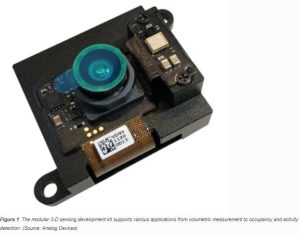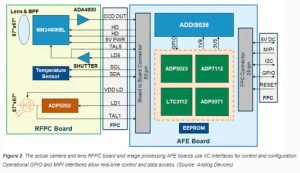Robots and machine vision devices use a variety of feedback mechanisms to assure accuracy. Discerning 3-D spaces with reasonably good accuracy can be done in several ways. So far, optical, sonic, and mechanical vision and sensing techniques have been employed with adequate levels of success. More demanding requirements force us to sharpen our already sharp pencils. Next-generation vision-based designs center on more precise depth and volume sensing with higher accuracy.
The techniques used so far have been okay for the problems at hand. The lowest cost mechanical depth or surface sensors can be as simple as a spring-loaded linear trimpot or limit switch.
When it comes to precision, sonic and optical techniques have proven more resolute without the need for moving parts. Optical distance sensing is used for simple proximity detection and more precision range finding. Proximity from less than a millimeter to 8 meters can be discerned as a digital go/no-go signal indicating the presence or absence of a target.
Thanks to the low-cost, high-resolution modern generation of cameras, video techniques have been at the forefront of distance and volumetric measurement. Next-generation design and requirements push device manufacturers to offer high-performance solutions.
More Need for More Options
In addition to machines needing higher precisions, the post-pandemic world created the need to detect people and occupancy numbers in a given location. Spacing between people is a relatively new requirement many must incorporate. A similar condition requiring attention is dementia. In assisted living facilities, the ability of an all-encompassing computer system to track wandering patients’ locations is crucial.
Industrial and factory applications too can take advantage of more robust and accurate distance and volume measurement subsystems. As more advanced fabrication technologies progress and merge, feedback on accuracy, position, direction, speed, and depth becomes critical for next-generation fabrication machines. For example, milling machines rely on precise motors and gear assemblies to correctly position cutting and grinding heads. Too deep, and a cutting head will break. Too shallow, and too much material is left. These machines will hit the right spot with accurate distance sensing, even if calibration is off. Closed-loop feedback produces better results. CNC machines, 3-D printers, and laser/plasma cutting and welding machines also benefit from higher accuracies of closed-loop feedback.
Newest Innovations
Analog Devices anticipated a growing need for volumetric sensing and measurement over many applications. The AD-FXTOF1-EBZ is a dedicated modular video engine with embedded Time of Flight (ToF) distance measurement built in (Figure 1).
The VGA resolution of 640×480 at 30 frames per second allows easy integration as a peripheral function to a host application supervisor. It features a two-lane Mobile Industry Processor Interface (MIPI) that can use a 25-pin or 15-pin flex cable to an interposer board.
The 940nm IR laser is an eye-safe vertical-cavity surface-emitting laser (VCSEL), which reduces manufacturing costs by eliminating the right-angle emitter configuration. It also touts its ability to operate in high light conditions thanks in part to the optical 940nm bandpass filter. This helps block noise and interference from external sources. A batwing style diffuser is used to provide the receiving lens with a precise 87-degree by 67-degree field of view.
Performance-wise, the video depth finder has two settable ranges it can operate within. A 20cm to 180cm range and a 50cm to 300cm range maintain a 2 per cent accuracy. It will require a 5V 2A power supply rated from -20ºC to +75ºC, making it somewhat tough and rugged environmentally.
The SDK development kit style interface allows it to connect to a host microprocessor, microcontroller, or single-board computers like Raspberry Pi or Nvidia (Figure 2). The SDK also provides OpenCV, Open C/C++, Python, MATLAB, Open3D, and RoS wrappers so that developers can use them to simplify application development. Connection options include USB, Ethernet, or Wi-Fi, and reference design and bill of materials are available.
Conclusion
The need for fast and resolute image and distance sensing allows designers to create next-generation sensors, robots, vehicles, and safety systems. The AD-FXTOF1-EBZ from Analog Devices lets you test the water quickly and easily. Expect higher resolution, faster frame rates, and longer distances with future versions of this technology as it gets adopted across different home and industrial applications.
Article Courtesy: Mouser Electronics










